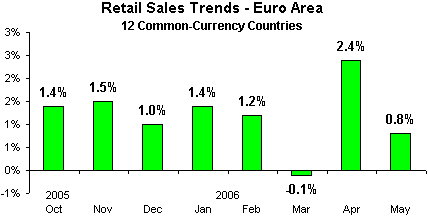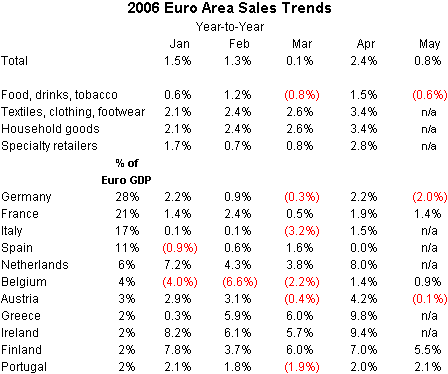IDEX Online Research: Europe High Street Sales Volatile
July 27, 06
After posting strong retail sales in April, Euro-Zone merchants saw consumer demand weaken sharply in May. On a year-over-year basis, retail sales in the Euro-Zone (12 countries with a common currency) were up a meager 0.8 percent in May. Retail sales for all 25 European Union countries were somewhat stronger – up 2.2 percent in May 2006 over the same month a year ago. The graph below summarizes retail sales trends on a year-over-year basis for the Euro-Zone.

Source: EuroStat
Retail sales in the Euro-Zone have not only been more volatile than analysts’ expectations, but they have also been below forecasters’ projections. In addition, these results run counter to the Bloomberg Retail PMI, which measures retail sales at 1,000 large retailers in the Euro-Zone. The PMI index rose to 56.3 from 54.6 in May, signaling a month of strengthening growth, though some of the increase was likely linked to the enthusiasm over the World Cup.
If retail sales for the three-month period March-May 2006 are compared to the same period a year ago, they are running ahead by 1.1 percent, a very small increment that is below the average gain for the second half of 2005.
Food, beverage, and tobacco sales were the weakest sectors in May, while household goods and sales in specialty retailers were strong in the month. Jewelry sales have not yet been reported for May, but the signs are not encouraging for this category.
Divergent Demand
The European consumer market appears to be divided into two camps: Euro-Zone (common currency) households who have kept their purse strings tight versus their counterparts outside the currency area who are spending with gusto. While Euro-Zone retail sales were up only modestly in May, retail sales for the entire 25-country area rose solidly, fueled by demand in the Baltic region and
Personal consumption in the Euro-Zone under-performed the aggregate economic expansion in 2005, but rebounded in the first quarter of 2006. Although this is a promising sign for the Euro-Zone economy, retail spending in the common-currency region remains weak, indicating that high street sales are dismal. While we expect the June and July figures to pick up as a result of the World Cup championships, the underlying weakness of retail demand is a source of concern for future economic growth in the common-currency area.
Outside the Euro-Zone, consumers apparently have a more positive attitude toward shopping. Both the Baltic region and
The table below highlights key consumer demand by major retail category as well as retail activity in some of the larger European Union markets.

Source: EuroStat
Outlook: Positive Trends Continue
Looking ahead, there are mixed signs for consumer spending in
In general, though, strong consumer morale, both within the monetary union and outside, suggests that households currently have a positive attitude towards increased spending. Sentiment, however, can easily change, which means that, at least within the Euro area where the economy remains fragile, consumers may continue to restrain their spending. Despite this reserved outlook, most countries in